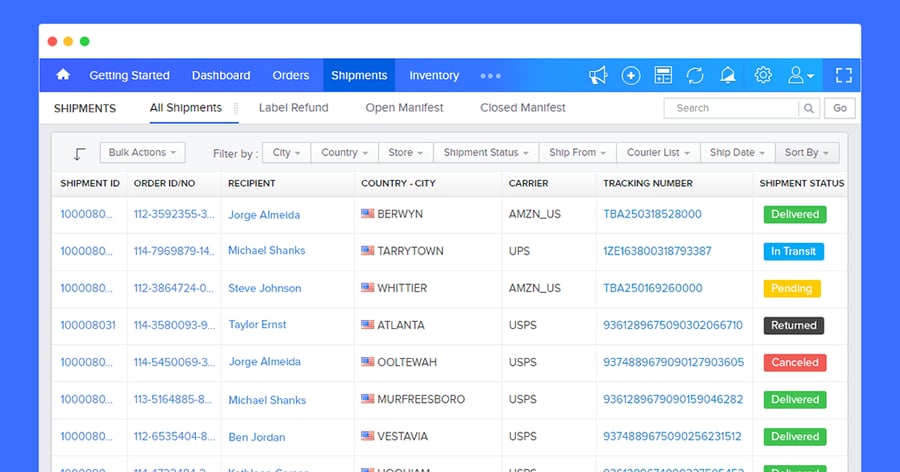
The eCommerce industry has exploded in recent years due to the retail sector's ongoing digital transformation and an exponential surge in demand resulting from the global pandemic. Consequently, more money than ever before flows through digital stores across nearly every conceivable vertical.
According to Statista, worldwide retail eCommerce sales hit $4.9 trillion in 2021 and are predicted to rise by 50% over the next four years, reaching a remarkable valuation of $7.4 trillion by 2025.

Source: Statista
It's safe to say things are looking bright for the future of the eCommerce sector. However, while this growth may appear to be excellent news to all business owners, it's wise to note that scaling an eCommerce store comes with inherent risk. From financial woes to micromanaging mishaps, scaling can often present more problems than it’s worth — especially if you don't know how to protect your business throughout sustained growth.
The Hidden Dangers of Scaling Your Business
At its core, scaling is typically a sign that a business is headed in the right direction. However, the grass is not always greener on the other side. When you ramp up operations, new problems can present themselves as your list of responsibilities increases and the stakes get higher.
For example, there will inevitably come a point where you will need to take on employees to share the workload. Of course, this brings a different dynamic into the picture. The business owner will have to rely on an entirely new skillset (leadership/management) to extract maximum value from their efforts.
On that note, let's look at five of the most common issues that scaling eCommerce stores are confronted with, followed by tips on overcoming them.
1. Securing Sustainable Lines of Credit
Scaling typically requires an injection of cash. Whether you need more capital to buy inventory, purchase an automation tool, fund marketing expenses, or even hire employees, many store owners make the mistake of overburdening themselves by not carefully considering their financing options.
While there are plenty of solutions out there, it’s important to note that every method of raising capital has its own advantages and disadvantages. Furthermore, what works for one business model may not necessarily work for another, despite both companies operating in the eCommerce space.
For instance, equity investors (angel investors and venture capitalists) provide an excellent benefit because they bring valuable experience and networking connections to the table. However, this type of financing is dilutive, which means you will have to give up a percentage of ownership in your company (which could become a high cost if your scaling efforts are successful).
On the other hand, bank loans and other traditional lines of credit do not require you to hand over equity. However, while interest rates are typically low, securing a bank loan can be challenging due to the requirement of a strong credit score. Furthermore, many banks frequently request some form of collateral if you do not repay the loan, which can put bank loans out of reach for most eCommerce stores.
2. Forecasting Demand
Forecasting the future demand of your eCommerce company is a critical component of successful scaling, although it is a challenging skill to master. This is because the primary data source used for forecasting is historical. Estimating future sales and how they may fluctuate when you ramp up operations and enter new markets can be tricky. Nevertheless, poor forecasting can lead to a multitude of issues, such as:
- Unstable inventory
- Deteriorating supplier relationships
- Increased shipping costs through expediting
- Poor cash flow management
3. Not Changing Management Structure as Growth Occurs
Solopreneurs run many eCommerce stores through business models such as dropshipping, private labeling, white labeling, and on-demand production. Yet, when demand increases and more orders come through the door, the responsibility can soon become too much for one person to bear.
Suppose an eCommerce store owner lacks the requisite skill set and experience to manage and delegate tasks effectively. In that case, they could inadvertently generate bottlenecks in production when they bring new employees on board. On the other hand, if you already employ people in your company, you will likely need to adjust your management structure as you expand, which can reduce efficiency and cause disruption.
4. Retaining Customers
According to the Harvard Business Review, acquiring a new customer is approximately five to twenty-five times more costly than retaining an existing one. Despite this well-known fact, many eCommerce stores struggle with retaining customers while they scale. This is because it is notoriously difficult to maintain high levels of customer service as you expand operations.
To put this in context, a SEMRush survey found that 14 percent of consumers left a company because it didn’t know how to manage their complaints, and 61 percent of retail organizations rank customer retention as their most formidable challenge. It's no surprise that maintaining or improving CLV (customer lifetime value) is one of the most critical issues that scaling eCommerce stores must overcome.
5. Managing Inventory and New Supply Chains
Inventory and supply chain management is an integral aspect of eCommerce operations. As you increase your output, managing inventory while maintaining relationships with supply chain vendors will become increasingly complex. For example, you may need to purchase new warehouse space to keep your stock, or you may need to find a new supplier if your current contact cannot meet your new demand.
For many eCommerce business owners, scaling also means selling products on additional channels, such as Amazon, Etsy, eBay, and Alibaba. Taking such steps to grow your eCommerce business is next to impossible when you rely only on manual inventory management, which will soon become unfeasible as scaling begins due to complications with the order fulfillment process, shipping, and logistics.
How to Overcome eCommerce Scaling Issues
Fortunately, it's not all doom and gloom when scaling your eCommerce business. With a few careful tweaks and a healthy dose of strategic planning, your store can run like a well-oiled machine even as you increase your output. On that note, let's look at five tips for protecting and preparing your business for scaling.
1. Choose the Right Source of Funding
Revenue-based financing is a practical alternative in which businesses raise capital based on projected revenue. Companies receive an injection of cash in exchange for a percentage of their revenue (ranging from 5% to 25%) until the loan is repaid in full. The downside is that if growth slows and scaling fails, it will take a long time to repay the debt, resulting in substantial cash flow issues.
Ecommerce funding platforms, such as 8fig, also provide a new alternative to traditional financing for entrepreneurs who do not want to surrender equity in their companies. These platforms provide needs-based funding for eCommerce businesses based on supply chain projections, which confirm each seller's growth trajectory using supply chain analytics. As a result, each plan is tailored to your unique circumstances and features a flexible remittance schedule, so you are unlikely to get overburdened with repayments, preserving your cash flow.
You must assess all of the options available to choose which funding source is right for your business. Be that as it may, you mustn’t make the mistake of securing finance on poor terms out of desperation to scale your business.
2. Implement Predictive Analytics to Forecast Future Demand
Predictive analytics are helpful for forecasting market demand, predicting consumer behavior, enabling dynamic pricing, and personalizing product offerings. This is accomplished by identifying links between multiple client data elements such as purchase history, demographic data, social media sentiment, online behavior data, etc. As a result, to begin utilizing demand forecasting, you must first obtain quantitative and qualitative data, such as monthly sales averages, underlying trends, and seasonal trends.
By understanding what happened previously and comparing it to what is happening currently, you’ll be able to formulate a map of what will likely occur in the coming weeks, months, and years. If the trends you uncover appear unfavorable to your current business model, you can either scale back your operations or readjust your product offerings to suit the market conditions. Thus, forecasting typically functions as a risk mitigation tool that allows you to master your business inputs to control its outputs better.
3. Build an Efficient and Effective eCommerce Company Structure

Now the time has come to scale your eCommerce store; you need to create an effective team structure to help you achieve your goals. Which structure you choose is entirely dependent on your circumstance and personal preference. However, as your team grows, you will eventually need to establish independent departments responsible for various aspects of operations, such as:
- Product development
- Sales and marketing
- Customer service
- Human Resources
- Business analysis
In addition, it would be wise to brush up on the soft skills required for effective management, such as leadership, delegation, communication, transparency, and time management.
4. Execute Customer Retention Strategies
As discussed, customer retention is often one of the first things that suffer when an eCommerce store scales, especially as they open new channels. Fortunately, there are plenty of strategies out there that can help you improve retention rates and increase customer lifetime value. Let's take a look at a few of the most effective, as per a Campaign Monitor article:
- Establish email marketing campaigns
- Introduce customer loyalty programs
- Implement a customer referral strategy
- Make customer service and experience a top priority
- Use personalization to improve marketing campaigns
- Nurture customer relations on social media channels
Customer retention is one of the most effective means of enhancing profitability, raising brand recognition, and creating loyal brand advocates, all of which will set your company in great stead as it enters a sustained period of growth.
5. Automate Inventory Management
Since manual management does not allow for scalability, you must automate your inventory procedures using inventory management software. These solutions simplify workflows and save time by customizing your retail automation with pre-built conditions.
With the successful implementation of inventory management software such as Orderhive, you can get a handle on inventory, maintain adequate stock levels, sync inventory tracking across all channels, compile real-time inventory data, and leverage insight. All of this can be used to capitalize on opportunities, boost sales, and scale your eCommerce business.

Source: Orderhive
Best of all, you'll be able to focus on other essential duties knowing that inventory is taken care of while drastically reducing the possibility of human error since you won't have to rely on manually updated spreadsheets.
In Summary
With the booming eCommerce sector, business owners face more demand than ever. For many entrepreneurs, the logical next step is to scale operations to meet this demand and drive more revenue through the business. However, as competition continues to rise and consumer demands remain sky-high, scaling too quickly or without an effective plan can cause many eCommerce stores to fail.
Consequently, expanding your eCommerce business necessitates solid foundations, smart business goals, and the commitment of time and effort to achieve them. It will also require a substantial financial investment to implement new software solutions that aid in automating processes such as inventory management, demand forecasting, and customer support.
Above all, remember to take the time to carefully consider your options, and don't bite off more than you can chew. Keep your purpose in mind, build a competent team around you, and focus on maintaining relationships with customers. If you can achieve all of this, you will be well on your way to finding success in the coming months and years. Good luck!





Leave a reply or comment below